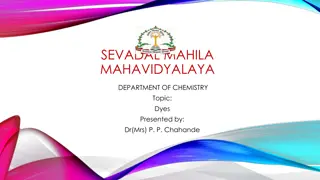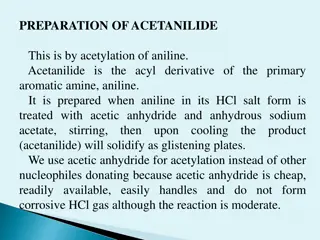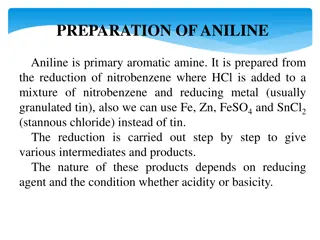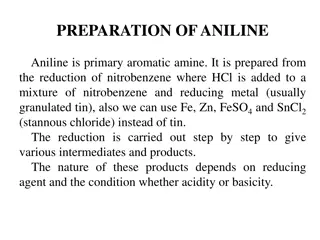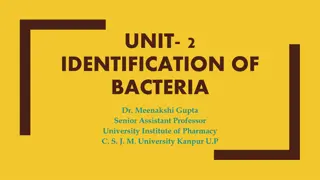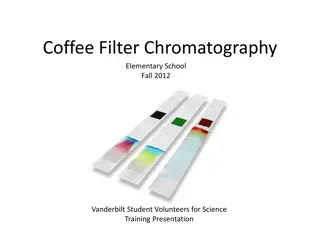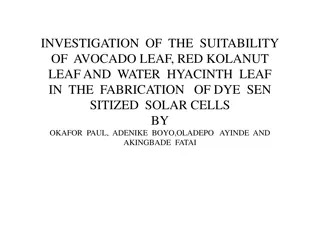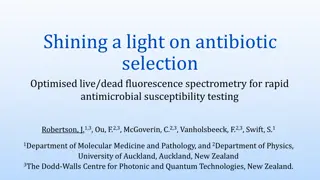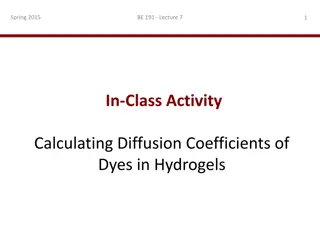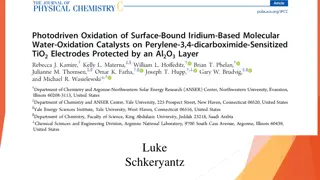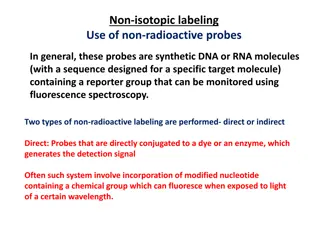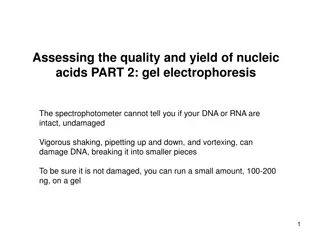Preparation of 2,3-Diphenyl quinoxaline
Quinoxaline, an organic compound, is synthesized through the condensation of benzyl with 1,2-phenylene diamine in this practical organic chemistry experiment at Salahaddin University. Quinoxaline and its derivatives have various applications in dyes, pharmaceuticals, and antibiotics. The process inv
0 views • 9 slides
Evolution of Histochemistry: A Journey Through Scientific Breakthroughs
Delve into the historical review of histochemistry, exploring its roots in the assessment of chemical compounds within cells and tissues using stains and dyes. Uncover the classification of histochemical methods, from chemical to biological approaches, and gain insights into the development and goal
0 views • 16 slides
Understanding Dyes: Classification and Chemistry in Chemistry Department of Sevadal Mahila Mahavidyalaya
Dyes are organic compounds that impart color to various substrates. Dr. P. P. Chahande presents an in-depth look into dyes, including their classification based on source material and chemical structure. Natural and synthetic dyes are explored, along with a breakdown of different chemical classifica
1 views • 17 slides
Understanding Fluorescence Microscopy: Principles and Applications
Fluorescence microscopy, pioneered by British scientist Sir George G. Stokes, reveals hidden details in specimens using fluorescent dyes that emit light of longer wavelengths. This innovative technique allows for visualization of cellular components that are otherwise colorless under conventional mi
0 views • 19 slides
Preparation of Acetanilide: A Detailed Overview
Acetanilide is synthesized through the acetylation of aniline using acetic anhydride and anhydrous sodium acetate, resulting in the formation of glistening plates upon cooling. Acetylation is preferred over other methods to control reactivity, and the mechanism involves the role of HCl. By deactivat
0 views • 9 slides
Preparation of Aniline from Nitrobenzene Reduction
Aniline, a primary aromatic amine, is prepared through the reduction of nitrobenzene using a mixture of nitrobenzene and a reducing metal (such as tin). Various intermediates and products are obtained depending on the reducing agent and conditions. Aniline is initially obtained as a salt form and is
0 views • 10 slides
Preparation of Aniline: Aromatic Amine Synthesis from Nitrobenzene
Aniline, a primary aromatic amine, is synthesized from nitrobenzene through a stepwise reduction process using various reducing agents. The addition of HCl to nitrobenzene with a reducing metal like tin yields aniline chloride. Subsequent treatment with NaOH liberates the free amine through steam di
0 views • 10 slides
Bacteria Identification Techniques: Staining and Microscopy Overview
Staining techniques in microbiology play a crucial role in visualizing bacteria under microscopes. This content covers the importance of staining, types of dyes, wet and dry mounts, hanging drop technique, and different types of staining methods employed in identifying bacteria. Explore the basics o
0 views • 39 slides
Coffee Filter Chromatography in Elementary School Science Presentation
Discover the fascinating world of chromatography through an engaging elementary school science presentation. Learn about mixtures, separation techniques, and the process of paper chromatography using food coloring dyes. Explore how chromatography can separate different components in mixtures and wit
0 views • 10 slides
Exploring Natural Dyes in Textile Wet Processing
Natural dyes, sourced from plants, minerals, and animals, have made a resurgence in textile dyeing due to environmental concerns. This online class covers the origin, classification, and characteristics of natural dyes such as Indigo, Indian Madder, Turmeric, Marigold, Henna, Tea, and Onion. Discove
0 views • 18 slides
Sawdust as a Low-Cost Adsorbent for Water Treatment
Sawdust, a renewable natural resource, has been studied for its effectiveness as an adsorbent for removing contaminants from water. It contains cellulose, hemicellulose, lignin, and other components that aid in adsorption. Research indicates its suitability for removing dyes, toxic salts, and heavy
0 views • 22 slides
Investigation of Avocado, Red Kolanut, and Water Hyacinth Leaves for Dye Sensitized Solar Cells
This study explores the potential of using natural plant dyes from avocado leaf, red kolanut leaf, and water hyacinth leaf in fabricating dye sensitized solar cells (DSSCs). The introduction discusses the need for alternative energy sources due to global warming, with DSSCs offering a low-cost and e
0 views • 34 slides
Analysis of Absorption Properties of Conjugated Dyes
The analysis focuses on the absorption properties of conjugated dyes such as 1,1-diethyl-2,2-cyanine iodide (red), 1,1-diethyl-2,2-carbocyanine iodide (blue), and 1,1-diethyl-2,2-dicarbocyanine iodide (turquoise). It involves calculating lambda max for each dye based on a particle in a box model, co
0 views • 15 slides
Optimised Live/Dead Fluorescence Spectrometry for Antimicrobial Susceptibility Testing
This study focuses on the optimisation of live/dead fluorescence spectrometry for rapid antimicrobial susceptibility testing. The research uses fluorescent dyes to distinguish between live and dead cells, providing a potential method for quick antimicrobial resistance diagnostics. The experiment inv
0 views • 16 slides
Understanding Dye-Sensitized Solar Cells and Types of Dyes in Solar Cell Technology
Explore the world of dye-sensitized solar cells and the various types of dyes used in these innovative solar energy technologies. Discover the difference between metal-complexes and organic dyes, learn about the advantages and disadvantages of different dyes, and delve into the absorption spectra of
0 views • 16 slides
Understanding Diffusion Coefficients of Dyes in Hydrogels
Explore the calculation of diffusion coefficients of dyes in hydrogels based on factors like molecular weight, matrix mesh size, temperature, and chemical properties. Learn through in-class activities to determine the diffusion coefficients in different hydrogel concentrations, assess the applicabil
0 views • 6 slides
Understanding Vat Dyes: Properties, Dyeing Process, and Limitations
Vat dyes are known for providing excellent color and fastness properties to textile materials, especially natural and manmade fibers. The dyeing process involves steps like aqueous dispersion, vatting, absorption by fibers, re-oxidation, and soaping off to ensure colorfastness. However, there are ce
0 views • 25 slides
Advancements in Dye-Sensitized Photoelectrochemical Cells
History traces the development of photoelectrochemical cells since 1972, highlighting the progress, challenges, and state-of-the-art dyes used, with an emphasis on improving performance through innovative solutions like Al2O3 layers. Key issues such as dye degradation and electron-hole recombination
0 views • 15 slides
Understanding the Principles of Staining in Histopathology
Staining is a crucial technique in histopathology that involves adding specific dyes to biological substrates to visualize and differentiate cell and tissue components. This chapter covers the principles of staining, types of stains used, factors influencing staining affinity, and common stains empl
0 views • 43 slides
Non-Isotopic Labeling for Molecular Detection
The use of non-radioactive probes in molecular detection involves synthetic DNA or RNA molecules with specific target sequences and reporter groups detectable via fluorescence spectroscopy. Direct and indirect labeling methods utilize fluorescent dyes or enzymes conjugated to modified nucleotides, a
0 views • 20 slides
Gel Electrophoresis for Assessing Nucleic Acid Quality
Gel electrophoresis is a crucial technique for assessing the quality and yield of nucleic acids such as DNA and RNA. It separates DNA fragments based on size, allowing researchers to determine the integrity of the nucleic acids. By running a small amount of sample on a gel and using DNA-binding dyes
0 views • 9 slides
Evolution of Chemical Industry from Coal Tar to Environmental Regulations
The story traces the evolution of the chemical industry from the discovery of coal tar in 1856 to the development of aniline dyes, resulting in the growth of major chemical companies. However, the environmental impact became a concern, leading to the Toms River Superfund Site and the implementation
0 views • 31 slides


